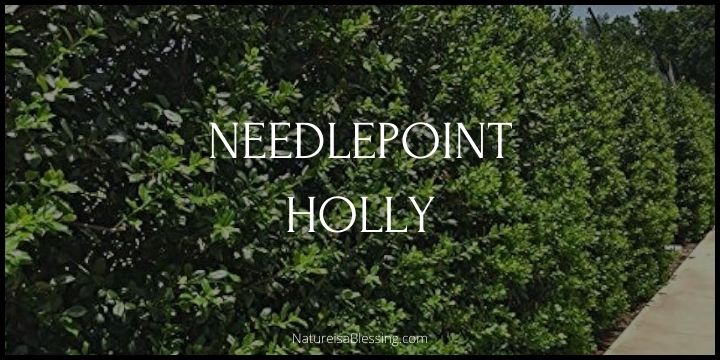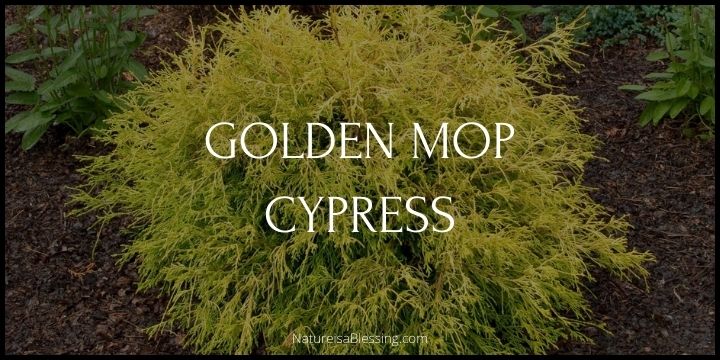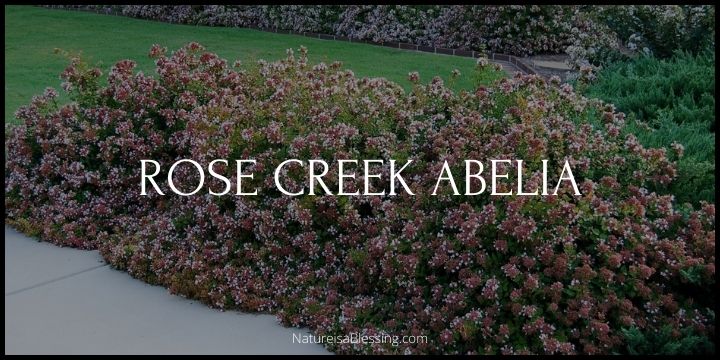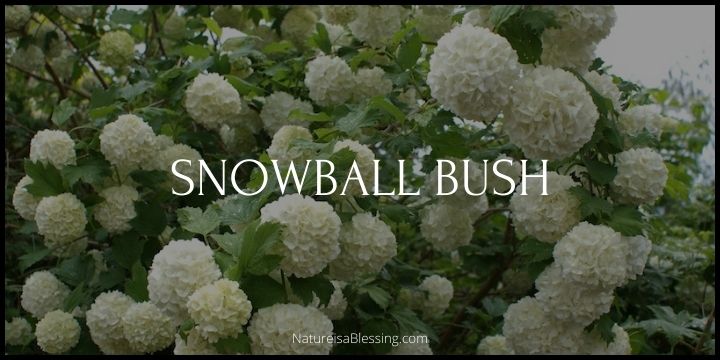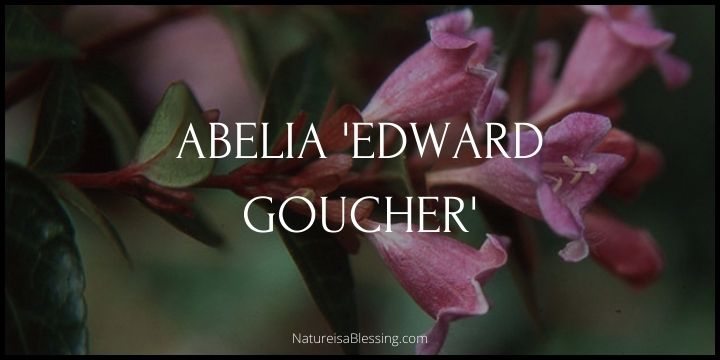Hicks Yew Hedge: How to Plant, Grow, and Care
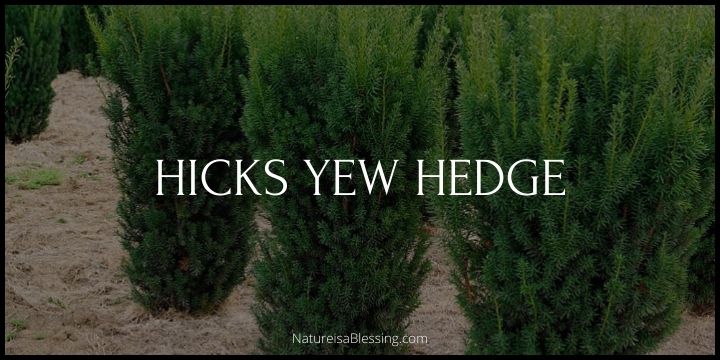
What is Hicks Yew?
Hicks Yew, scientifically known as Taxus x media ‘Hicksii’, is a hybrid yew variety that is popularly used in landscaping. It is an evergreen shrub that is known for its dense, dark green foliage and columnar growth habit.
The plant is often used as a hedge or screen due to its dense foliage, providing excellent privacy. It can reach heights of 10 to 20 feet and spreads about 4 to 6 feet. The Hicks Yew is adaptable to a variety of soil conditions but prefers well-drained soil. It also has a tolerance for both full sun and part shade.
One of the notable characteristics of the Hicks Yew is its red, berry-like fruits that attract birds. However, it’s worth noting that all parts of the plant are poisonous if ingested by humans or pets.
The Hicks Yew is a slow-growing plant with a low maintenance level, making it a favorite among gardeners and landscapers. It is hardy in USDA zones 4-7.
Fast Facts About Hicks Yew
| Parameter | Information about Hicks Yew |
|---|---|
| Country Or Region Of Origin | Asia, Europe, North Africa |
| Plant Type | Evergreen Shrub |
| Family | Taxaceae |
| Genus | Taxus |
| Sun Exposure | Full sun to part shade |
| Season of Interest | All year round |
| Water | Medium |
| Maintenance level | Low |
| Growth rate | Slow |
| Height | 10 to 20 feet |
| Spread | 4 to 6 feet |
| Spacing | 5 to 6 feet apart for a dense hedge |
| Soil Type | Adaptable to most soil types, prefers well-drained soil |
| Soil pH | Acidic, Neutral, Alkaline |
| Soil Drainage | Well-drained |
| Habit/Form | Upright, Columnar |
| Attracts | Birds (for the berries) |
| Characteristics | Dense foliage, dark green leaves |
| Tolerance | Drought, deer, air pollution |
| Suggested Use | Privacy screen, hedge, foundation plantings, specimen plant |
| USDA Plant Hardiness Zone | 4-7 |
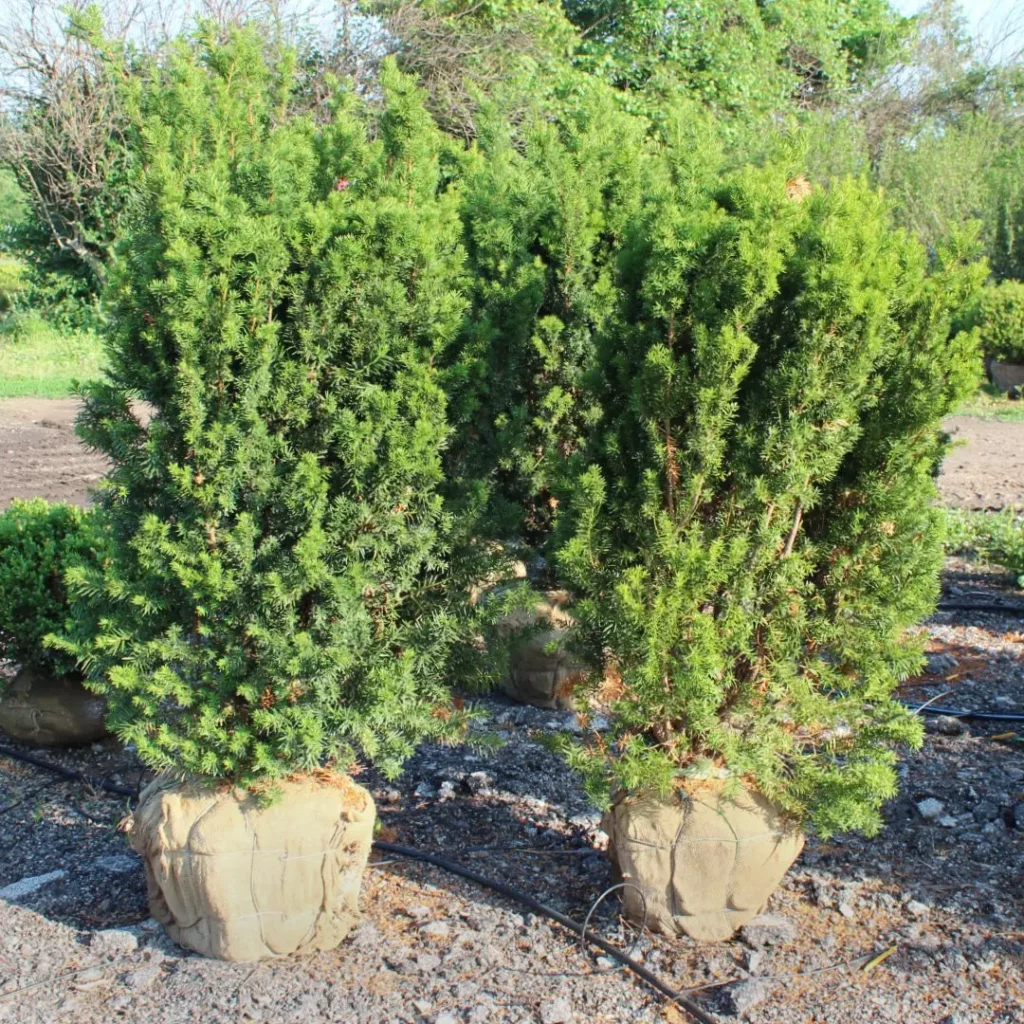
How to Grow Hicks Yew: The Ultimate Guide
Hicks Yew (Taxus x media ‘Hicksii’) is a popular evergreen shrub renowned for its dense, dark green foliage and columnar growth habit.
It’s an excellent plant for hedges or screens, providing privacy and adding a touch of elegance to any landscape. Hicks Yew thrives in USDA hardiness zones 4-7 and prefers well-drained soil. It can tolerate full sun to part shade.
Propagation
- Timing: The best time for propagation is late summer. The plant will have semi-hardwood cuttings ready by this time.
- Taking Cuttings: Choose a healthy branch and cut a 6-8 inch long section. Make sure the cutting has several nodes (the bumps where leaves attach), and remove the leaves from the bottom half of the cutting.
- Rooting Hormone: Dip the cut end into a rooting hormone. This step is not absolutely necessary but it can enhance root development.
- Planting the Cutting: Fill a pot with a mix of peat and perlite, which provides excellent drainage necessary for root development. Make a hole in the center and insert the cutting. Firm the soil around the cutting to hold it upright.
- Aftercare: Place the pot in a location with indirect light and maintain a high humidity level around the cutting by covering it with a plastic bag or placing it in a mini greenhouse. Keep the soil consistently moist, but avoid waterlogging as it can cause the cutting to rot.
- Root Development: After several weeks, you should see new growth, indicating that the cutting has developed roots. At this point, you can transplant it into a larger pot or directly into the garden.
Planting
- Choosing the Site: Hicks Yew prefers a site with well-drained soil. It can tolerate full sun to part shade, but in hotter climates, it appreciates some afternoon shade.
- Preparing the Site: Dig a hole twice as wide and just as deep as the root ball. Amend the soil with organic matter to improve its fertility and drainage.
- Planting: Place the plant in the hole, ensuring that the top of the root ball is level with the surrounding soil. Backfill the hole and firm the soil gently to remove any air pockets.
- Aftercare: Water the plant thoroughly after planting, and continue watering regularly during the first year to help it establish a strong root system. Apply a layer of mulch around the base of the plant to conserve moisture and suppress weeds.
Soil
Hicks Yew is quite adaptable and can thrive in a range of soil types, including clay, loam, and sandy soils. However, it prefers well-drained soil as waterlogged conditions can lead to root rot.
The pH of the soil can be acidic, neutral, or alkaline. If you’re unsure about your soil’s pH level, you can test it using a soil testing kit available at most garden centers.
Before planting, it’s beneficial to amend the soil with organic matter such as compost or well-rotted manure. This not only improves soil fertility but also enhances its structure and drainage, which is particularly beneficial if your soil is heavy clay or sandy.
Fertilizer
Hicks Yew doesn’t have high nutrient demands, but a balanced slow-release granular fertilizer can promote healthier growth. Look for a fertilizer designed for evergreen shrubs that contain equal proportions of Nitrogen (N), Phosphorous (P), and Potassium (K) – such as a 10-10-10 formula.
Apply the fertilizer in early spring before new growth starts. Here is a step-by-step guide to fertilizing your Hicks Yew:
- Measure the Area: Measure the square footage of the area around your yew. You’ll need this to calculate how much fertilizer to use.
- Calculate Fertilizer Amount: Check the package for how much fertilizer to apply per square foot and calculate the total amount needed.
- Apply Fertilizer: Sprinkle the fertilizer evenly around the base of the plant, starting a few inches away from the trunk and extending out to the drip line (the outermost circumference of the tree canopy where water drips onto the ground).
- Water Well: After applying the fertilizer, water the area thoroughly to help the nutrients seep into the soil and reach the roots.
Note: it’s always better to err on the side of under-fertilizing. Too much fertilizer can lead to salt build-up in the soil, which can damage the roots.
Water Requirement for Hicks Yew
Hicks Yew has moderate water needs. While it’s a relatively drought-tolerant plant once established, it requires regular watering during its first year of growth to help it establish a strong root system.
- Frequency: Water your Hicks Yew regularly during the first year after planting, aiming for about an inch of water per week including rainfall. This may require watering 2-3 times per week during hot, dry periods.
- Method: Water deeply rather than frequently sprinkling the surface. Deep watering encourages roots to grow down into the soil, resulting in a more drought-tolerant plant.
- Check Soil Moisture: Before watering, check the soil moisture by sticking your finger about an inch deep into the soil. If the soil feels dry at this depth, it’s time to water.
- Mulch: Applying a layer of mulch around the base of your Hicks Yew can help conserve soil moisture and regulate soil temperature.
Sunlight Requirement for Hicks Yew
Hicks Yew is adaptable when it comes to light conditions. It can grow in full sun to part shade, thriving in sites with filtered light or full sun.
However, in hotter climates, it appreciates some afternoon shade to protect it from scorching.
- Full Sun to Part Shade: Plant your Hicks Yew in a location where it will receive at least 4-6 hours of sunlight per day. More sun will lead to denser foliage, but ensure the plant doesn’t get scorched in intense heat.
- Filtered Light: If you’re planting in a shaded area, ensure that the plant still gets filtered or dappled light for a portion of the day.
- Monitor Plant Health: Keep an eye on your plant’s health. If the foliage starts to yellow or the plant appears leggy (tall and spindly), it may be receiving too much or too little light.
Pests & Diseases
Hicks Yew is relatively resistant to pests and diseases, but there are a few issues that can affect this plant:
- Pests: The most common pests that target yews include mealybugs, scale insects, and weevils. Regularly inspect the plant for signs of infestation such as discolored or sticky leaves. If you notice any pests, treat them with an appropriate insecticide or horticultural oil.
- Diseases: Root rot can occur in poorly drained soil, so ensure your yew is planted in well-draining soil. Needle blight, a fungal disease, can also affect yews, causing needles to turn brown and die. Fungicides can help control this disease.
- Environmental Stress: Browning of foliage can occur due to winter burn, especially in exposed locations or during particularly harsh winters. You can protect your yews by wrapping them in burlap during the winter months.
Pruning
Hicks Yews have a naturally upright and narrow growth habit, which requires minimal pruning to maintain. However, if desired, they respond well to pruning and can even be sheared into formal hedges.
- When to Prune: The best time to prune is in late winter or early spring before new growth starts. However, avoid pruning in late summer or fall as this can stimulate new growth that may not harden off before winter.
- How to Prune: Use sharp, clean pruning shears to make clean cuts. Remove any dead, diseased, or damaged branches first. Then, shape the plant as desired, keeping in mind that heavy pruning may result in bare patches until the plant regrows.
- Maintenance Pruning: If your yew is grown as a hedge, it may require more frequent pruning to maintain the desired shape. You can shear the plant in early summer once the new growth has hardened off.
Note: always clean your pruning tools before and after use to prevent the spread of disease.
Special Considerations for Hicks Yew
- Toxicity: All parts of the Hicks Yew, especially the seeds, are toxic if ingested by humans and pets. Be cautious when planting Hicks Yew in areas accessible to children or pets.
- Deer Resistance: Hicks Yew is considered deer-resistant, which makes it a good choice for areas where deer may be a problem. However, in times of scarcity, deer may still browse on yews.
- Winter Protection: In areas with harsh winters, Hicks Yew can suffer from winter burn. Protect your plant by providing a windbreak or wrapping it in burlap during the coldest months.
- Growth Rate: Hicks Yew has a slow to moderate growth rate. If you’re planning a hedge, keep in mind that it might take several years for the plants to fill in fully.
- Spacing: When planting more than one Hicks Yew, space them adequately to allow for their mature size. This not only ensures each plant has room to grow but also promotes good air circulation, reducing the risk of disease.
- Sunburn: If planted in full sun, the leaves of the Hicks Yew may yellow or burn. If this happens, consider providing some afternoon shade or moving the plant to a location with dappled light.
Interesting Landscape Ideas for Hicks Yew
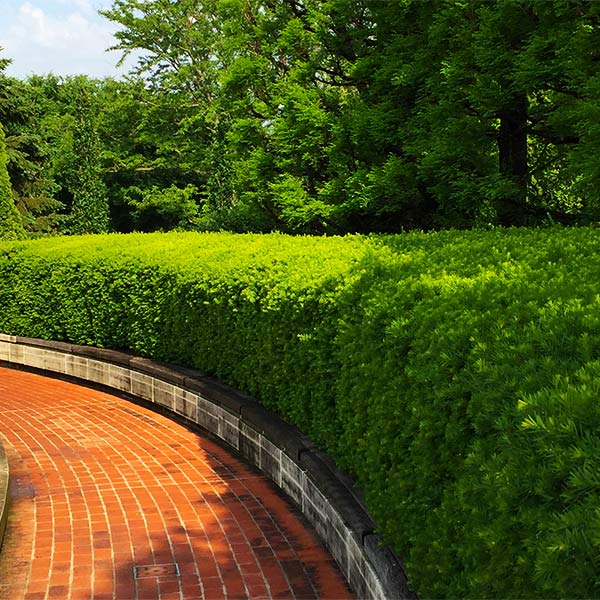
| Landscape Idea | Description |
|---|---|
| Formal Hedge | Hicks Yew grows in a naturally upright columnar shape, making it perfect for formal hedges. Its dense growth habit and dark green foliage provide an elegant backdrop in any garden setting. |
| Privacy Screen | Plant several Hicks Yews in a row to create a natural privacy screen. Its thick, evergreen foliage offers year-round privacy and noise reduction. |
| Foundation Planting | Hicks Yew can be used as a foundation plant because of its moderate height and narrow spread. It can help cover unsightly areas and add structure to your landscape. |
| Topiary | With its tolerance for heavy pruning, Hicks Yew can be shaped into various topiary forms. This could add a unique artistic element to your garden. |
| Accents in Mixed Borders | Hicks Yew can serve as a stunning accent plant in mixed borders. Its deep green foliage provides a beautiful contrast to flowering plants and deciduous shrubs. |
| Container Planting | Smaller Hicks Yews can be grown in containers for patios or decks. This allows you to enjoy their beauty even in small spaces or urban settings. |
| Bird Habitat | Although the seeds are toxic to humans and pets, they’re not harmful to birds. Planting Hicks Yews can help attract birds to your garden, providing them with shelter and food. |
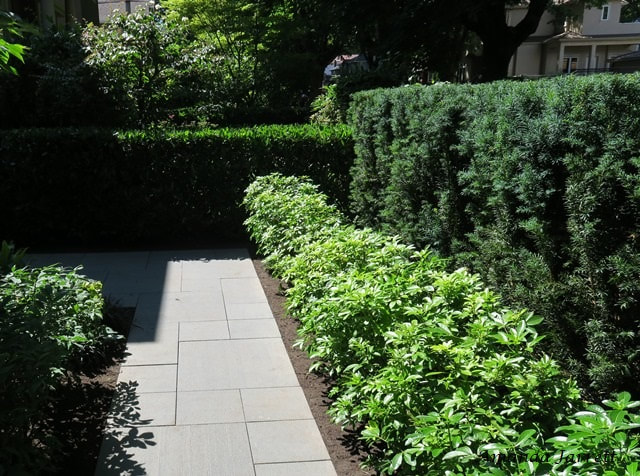
Where to Buy Hicks Yew?
- Pike Nursery
- Fast Growing Trees
- Petitti Garden Center
- Wasco Nursery
- Simply Trees
- Altum’s Garden Center
- Trees.com
- Van Dongen’s
Note: availability may vary, and it’s recommended to check each website for current stock and pricing.
Top 7 Hicks Yew Alternatives
| Plant Name | Features |
|---|---|
| Emerald Green Arborvitae (Thuja occidentalis ‘Smaragd’) | This evergreen shrub is known for its dense, emerald green foliage and narrow, pyramidal shape. Ideal for hedges or privacy screens. |
| Boxwood (Buxus spp.) | Another popular choice for formal hedges, boxwoods are compact evergreens with small, glossy leaves. They respond well to pruning and can be shaped into various forms. |
| Holly (Ilex spp.) | Holly plants offer dense growth and attractive berries. They are available in many varieties, some of which can match the size and shape of Hicks Yew. |
| Leyland Cypress (x Cupressocyparis leylandii) | Fast-growing and hardy, Leyland Cypress can quickly create a tall, evergreen screen. Its feathery foliage adds textural interest. |
| Japanese Holly (Ilex crenata) | With small, rounded leaves and a dense growth habit, Japanese Holly can resemble Hicks Yew. It’s a versatile plant that can be used for hedges or topiary. |
| Juniper (Juniperus spp.) | Junipers are hardy evergreens that come in a variety of shapes and sizes. Some upright varieties could serve as Hicks Yew substitutes. |
| Privet (Ligustrum spp.) | Privets are fast-growing plants often used for hedges. They feature glossy leaves and clusters of fragrant flowers. |
The Origin of Hicks Yew: A Detailed Historical and Botanical Overview
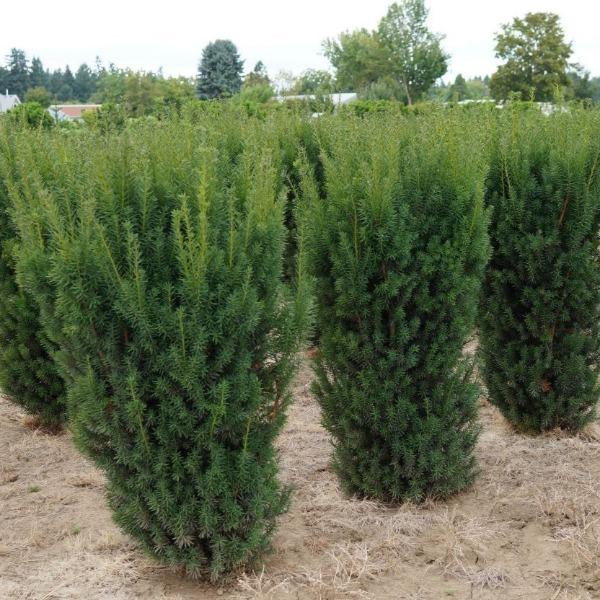
The Hicks Yew, botanically known as Taxus x media ‘Hicksii’, is a popular evergreen shrub renowned for its dense, dark green, needle-like foliage and bright red fruit-like structures called arils. This plant stands out due to its upright columnar growth habit, often reaching heights of 10-12 feet and a width of 3-4 feet.
Origins and Discovery
The Hicks Yew is a hybrid of English yew (Taxus baccata) and Japanese yew (Taxus cuspidata), hence the botanical name, Taxus x media. The specific cultivar ‘Hicksii’ was named after Henry Hicks, a notable nurseryman from Long Island, New York, who propagated this particular variety in the mid-20th century.
Unique Features and Uses
One of the most striking features of the Hicks Yew is its bright red arils, which, while toxic to humans and pets, provide food for birds. Its dense, evergreen foliage offers year-round visual interest, making it an excellent choice for hedges, privacy screens, or as a standalone specimen. Additionally, its tolerance for heavy pruning allows it to be shaped into various topiary forms, adding a unique artistic element to gardens.
Significance in Modern Botany
The Hicks Yew’s versatility, visual appeal, and adaptability to various growing conditions have cemented its status as a significant plant in modern botany. Its hybrid nature also makes it an interesting subject of study, offering insights into plant genetics and propagation techniques.
In conclusion, the Hicks Yew is more than just an attractive garden plant. Its rich history, unique features, and botanical significance make it a fascinating subject for both amateur gardeners and professional botanists alike.
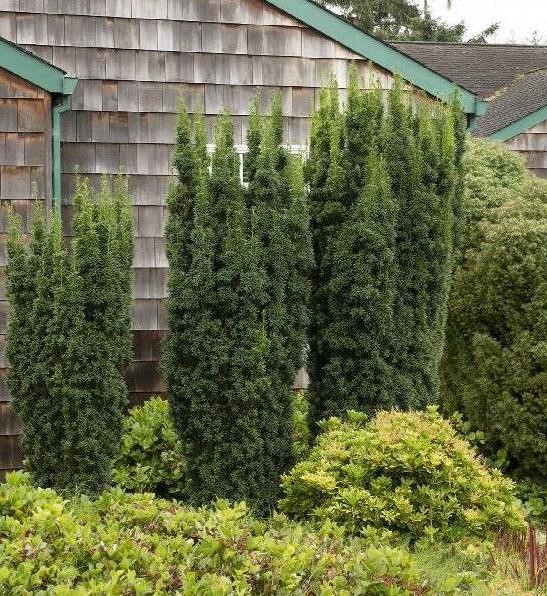
Frequently Asked Questions
1. How fast and tall does Hicks Yew grow?
The Hicks Yew grows at a moderate rate of about 1-foot per year on average. At maturity, it can reach heights of 10-12 feet and a width of 3-4 feet.
2. Is Hicks Yew a good hedge?
Yes, the Hicks Yew is considered a good hedge. It is a sturdy evergreen shrub that forms a thick, bushy barrier and retains its color and foliage in winter, making it excellent for hedges or privacy screens.
3. Is Hicks Yew hardy?
Yes, the Hicks Yew is considered very hardy. It thrives in growing zones 4 to 7 and is known as one of the easiest evergreen shrubs to grow in the northern US.
4. How much spacing should I give Hicks Yew?
When planting a Hicks Yew hedge, the recommended spacing is between 18 inches and 36 inches apart from center to center. The exact distance can vary based on your desired density for the hedge.
Also read:
